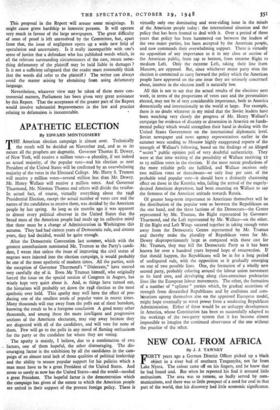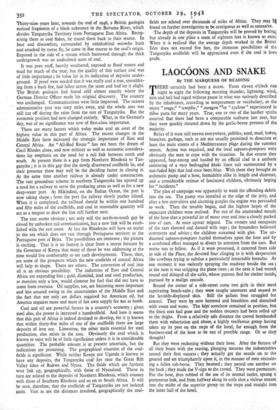NEW COAL FROM AFRICA
By J. J. TAWNEY
FORTY years ago a German District Officer picked up a black object in a river bed of southern Tanganyika, not far from Lake Nyasa. The colour came off on his fingers, and he knew that he had found coal. But when he reported his find it aroused little enthusiasm. The area was so remote, so badly served by com- munications, and there was so little prospect of a need for coal in that part of the world, that his discovery had little economic significance.
Thirty-nine years later, towards the end of 1946, a British geologist noticed fragments of a black substance in the Rovuma River, which divides Tanganyika Territory from Portuguese East Africa. Recog- nising them as coal flakes, he traced them back to their source. In heat and discomfort, surrounded by uninhabited miombo bush and attacked by tsetse fly, he came in due course to the coal's origin. Exposed in the side of a stream which burrowed through the thick undergrowth was an undoubted seam of coal.
It was poor stuff, heavily weathered, exposed to flood waters and mud for much of the year, but the quality of this surface coal was of little importance ; its value lay in its indication of deposits under- ground. If proof were needed that it was really coal a tree, smoulder- ing from a bush fire, had fallen across the seam and had 'set it alight.
The British geologist had found coal almost exactly where the German District Officer made his original discovery. The country was unchanged. Communications were little improved. The nearest administrative post was sixty miles away, and the whole area was still cut off during the rains from the rest of Tanganyika. But the economic position had now changed entirely. What, in the German's day, was of no significance was now of first-class importance.
There are many factors which today make coal an asset of the highest value in this part of Africa. The recent changes in the Middle East have increased the strategic importance of East and Central Africa. An "All-Red Route" has not been the dream of Cecil Rhodes alone, and now military as well as economic considera- tions lay emphasis on the need for a rail link between north and south. At present there is a gap from Northern Rhodesia to Tan- ganyika; it is in this gap that the newly discovered coalfields lie, and their presence there may well be the deciding factor in closing it. At the same time another railway is already under construction. The vast groundnut scheme in southern Tanganyika has opened up a need for a railway to serve the producing areas as well as for a new deep-water port. At Mikindani, on the Indian Ocean, the port is now taking shape ; from the port the railway slowly pushes inland. When it is completed, the railhead should be within one hundred and fifty miles of the coalfields, and coal in reasonable quantity will act as a magnet to draw the line still further west.
The rest seems obvious ; not only will the north-to-south gap be closed by unbroken rail communication, but a new link will be estab- lished with the east coast. At last the Rhodesias will have an outlet to the sea which does not run through Portuguese territory to the Portuguese port of Beira. The possibilities are immense ; the picture is exciting. That it is no fantasy is clear from a recent forecast by the Governor of Kenya that many of those he was addressing at the time would live comfortably to see such developments. These, then, are some of the prospects which the new coafields of central Africa will help to shape. There are others. The conversion of coal into oil is an obvious possibility. The industries of East and Central Africa are expanding fast ; gold, diarmind, lead and sisal production, to mention only a few, would clamour for fuel that did not have to come from overseas. Oil supplies, too, are becoming more important and less assured owing to the uncertainties of the Middle East and the fact that not only are dollars required for American oil, but America requires more and more of her own supply for nse at hone.
Coal and oil are powerful factors in a country's economy ; given steel also, the power is increased a hundredfold. And here it seems that this part of Africa is indeed destined to develop, for it is known that within thirty-five miles of one of the coalfields there are large deposits of iron ore. Limestone, the other main essential for steel production, also exists in the area. Obviously the coal which is known to exist will be of little significance unless it is in considerable quantities. The probable amount is at present uncertain, but the indications are promising. The geographical situation of the coal- fields is significant. While neither Kenya nor Uganda is known to have any deposits, the Tanganyika coal lies near the Great Rift Valley lakes of Rukwa and Nyasa. The fields which are furthest west link up, geographically, with those of Nyasaland. Those in turn are related to the deposits of Northern Rhodesia, which connect with those of Southern Rhodesia and so on to South Africa. It will be seen, therefore, that the coalfields of Tanganyika are not isolated units. Vast as are the distances involved, geographically the coal- fields are related over thousands of miles of Africa. They may found on further investigation to be cpntiguous as well as extensive.
The depth of the deposits in Tanganyika will be proved by borings but already in one place a seam of eighteen feet is known to exist, When it is realised that the average depth worked in the British Isles does not exceed five feet, the immense possibilities of the Tanganyika coalfields will be appreciated even if the coil is lowl grade.



































 Previous page
Previous page